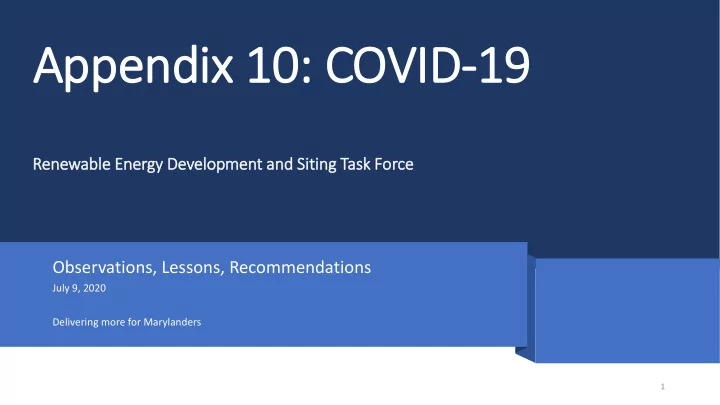

Appendix 10: COVID ID-19 19 Renewable le Energy De Development an and Si Sitin ting Task ask For orce Observations, Lessons, Recommendations July 9, 2020 Delivering more for Marylanders 1
How wil ill COVID ID-19 im impact the RE Development and Sit iting Task Force report? 1. COVID-19 Impacts, observations from the field 2. Post-COVID recommendations for REDS 3. Discussion for including a COVID-19 Appendix 2
Achieving Task Force Directives, including – 1. Recommendations to accelerate the Why this is responsible siting of clean and renewable energy projects 2. Recommendations to identify specific changes matters to the to state law, policies, procedures, regulations, resources and tools that would incentivize responsible RE development and siting. RE Development and Sit itin ing Task Force How are ratepayers benefiting? How has the solar industry performed? How can we reach more?
General Observations related to COVID-19 19 a) Visible results from changes in energy use. Clean air and clear skies emerged from quarantine photos globally. 4
Statewide Im Impact, National Le Leadership 5
General Observations related to COVID-19 19 b) Shift in energy use and consumption • Residential loads increase with increased home quarantine hours • Commercial office and retail loads decreased with closed or scaled back operations • Municipal- school districts loads decreased with closed facilities • Utilities regionally are seeing a net load reduction 6
General Observations related to COVID-19 19 C) Use and reliance on technology for communications increased a) Video conference apps/services b) Marylanders are innovating ways to manage forward D) Economic Impact: Major. Local, Statewide, National and Global Impacts E) Solar is one industry that is contributing economic stability during COVID . We have not been immune to job losses however solar offers continued statewide investment and ratepayer value Post-COVID. Policy updates can help keep the jobs and ratepayer benefit engine going. • How can we reach more? 7
Achievement to date: Solar installed is about 20% of the CEJA How is is solar performing? 14.5% goal I. Systems In-Service since 1998 generating over 2.8% of MD consumption II. Systems In-Construction – residential, community solar, C&I, muni/ed, USS I. Slowed initially, returning to the sites with new processes III. Systems In-Development – residential, community solar, C&I, muni/ed, USS I. Slowed initially, returning with new remote tools to support customer decisions, county and utility approvals. 8
Over 71,000 systems in-service I. Systems In-Service: Generating over 1,7450,000 MWh/yr NEM/ANEM generating more Delivering and uninterrupted than baseload, credits for future months. 1. Ratepayers with solar benefiting – NEM policies working a) Homeowners – using more onsite generation, reducing bills benefits from minimizing costs of increased consumption. NEM sends unused solar generation to the grid for local use and credits homeowner for future use. b) Muni-Schools – NEM/ANEM generating more than baseload, credits for future months. Closed schools and muni facilities with solar or participating with solar through MD NEM/ANEM are generating more than base load consumption. Surplus generation is distributed to the grid for local use and the school/muni is credited on future consumption. c) Commercial - NEM generating more than baseload, credits for future months 9
CS pilot program is currently capped at 400 MW, each 1MW can power Systems in Service: over 150 homes. Delivering and uninterrupted 2. Ratepayers subscribed to the emerging pilot community solar projects benefiting. Project dollars going right back to the local community. a) Resi subscribers – reducing impact of increased consumption with fixed discounts b) Resi subscriber savings can equate to 4-10 additional Stimulus checks when enrolled over 25 yrs c) Property owners receiving stable long-term lease revenue, available for multiple uses 10
II. Systems In-Construction: Initially interrupted, now returning to action 1. Residential systems construction a) This sector employs the most field teams and experienced the most jobs loss in the early months. Both installation crews and homeowners adapted to new procedures. Build rate can improve. 2. Commercial and Community Solar projects a) Like residential sector early COVID month’s saw project construction slowed or halted. b) New COVID procedures are in place for solar construction, this is one sector that is maintaining and can growth jobs in Maryland. 11
Achievement of CEJA goals will III. Systems In-Development: exceed an additional $14 billion Residential, community solar, C&I, muni/ed, USS 1. Resi demand is strong but challanged- delays with permitting and inspections continue to cause frustrations with ratepayers and installers 2. Some counties exploring online tools to improve but support is needed across the state. Dated permitting practices are unintentionally delaying rooftop deployment 3. Some homeowners are delaying decisions due to overall uncertainties and new development and outreach efforts utilizing door-to-door messaging has slowed. 4. Community Solar program registration and capacity allocation with utilities needs support for clarity to speed project implementations 12
III. Systems In-Development: Residential, community solar, C&I, muni/ed, USS 4. Commercial and Community Solar projects – Viable solar sites are a challenge a) Like residential sector early COVID months saw project development slowed or halted. Remote meeting tools deployed. b) Viable solar sites are a challenge. Chesapeake Conservancy GIS presentation. Chart by MDV-SEIA member firm 13
• A. Support expansion of NEM cap to accommodate more siting on Resi and C&I rooftop, parking lots and ground areas. • B. Provide access and expansion for commercial COVID Appendix property owners and state agencies to participate in ANEM. Recommendations • C. Support advancement of remote permitting and inspections statewide • D. Support increase ratepayer access to community solar and C&I projects with reduction of project personal property taxes to 20%. This encourages siting on qualified brownfields, parking lots, rooftops and other ground areas. • E. Others 14
Recommend
More recommend